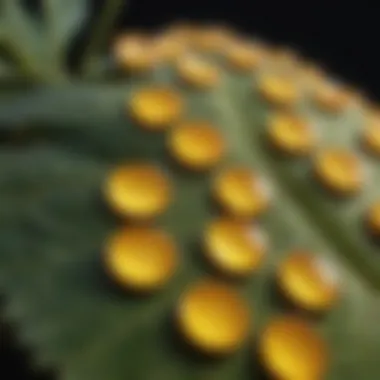Unveiling the Enigma of Yellow Dots Manifesting on Plant Leaves


Plant Health & Biology
Plant leaves displaying yellow dots can be a perplexing sight for any gardener or botany enthusiast. These peculiar markings could signify underlying issues within the plant's biology, serving as a visual cue to potential health concerns or environmental stressors. Understanding the origins and implications of these yellow dots is crucial in deciphering the well-being of your botanical companions.
Key Factors Influencing Yellow Dots Formation
Nutritional Imbalances
One significant factor contributing to the emergence of yellow dots on plant leaves is nutritional deficiencies. Essential elements such as nitrogen, phosphorus, potassium, and micronutrients play a pivotal role in maintaining the plant's metabolic functions and overall vitality. Insufficient uptake of these nutrients can manifest as yellow discoloration, potentially appearing as dot-like patterns on the foliage.
Environmental Stressors
Adverse environmental conditions, including excessive sunlight, temperature fluctuations, or poor air circulation, can exert undue stress on plants, prompting physiological responses that lead to the development of yellow spots. These stressors disrupt chlorophyll production and photosynthesis, leading to the characteristic yellowing observed on the leaves.
Pests and Diseases
Infestations by pests such as aphids, mites, or diseases caused by fungi and bacteria can also induce yellow discoloration on plant leaves. These pests and pathogens interfere with nutrient uptake and plant processes, resulting in the formation of distinctive yellow dots as a visual indicator of the plant's compromised health.
Implications for Plant Care
Recognizing the presence of yellow dots on plant leaves serves as a call to action for implementing appropriate care measures to address underlying issues. Conducting a thorough inspection of the plant, analyzing soil composition, and evaluating environmental factors can aid in resolving the factors contributing to the yellow discoloration. By identifying and rectifying the root causes, you can restore the plant's health and vibrancy, fostering optimal growth and foliage development.


Investigating Nutrient Levels
Periodically testing the soil for nutrient levels and p H balance can unveil deficiencies that may be triggering the appearance of yellow dots. Adjusting the fertilizer regimen or incorporating organic amendments can help replenish lacking nutrients, promoting healthy leaf coloration and growth.
Environmental Modifications
Mitigating environmental stressors by relocating the plant to a more suitable position with adequate light levels and ventilation can alleviate the physiological strain contributing to yellow spots. Creating a favorable microclimate for the plant by addressing humidity levels and temperature fluctuations can aid in restoring leaf health.
Pest and Disease Management
Implementing integrated pest management strategies and employing organic or targeted remedies can combat pest infestations and diseases, thereby preventing further yellowing of the plant foliage. Regularly monitoring plant health and practicing preventive measures are essential in safeguarding your plants against detrimental invaders.
Synthesizing Plant Care Practices
Introduction
Exploring the realm of yellow dots on plant leaves opens a door to understanding the intricacies of plant health. It is an issue that perplexes many gardeners and plant enthusiasts, signaling potential underlying problems that can affect the overall well-being of plants. By delving into the mystery of these peculiar yellow dots, we embark on a journey of unraveling the secrets that plants hold within their leaves.
What are Yellow Dots on Plant Leaves?
Yellow dots on plant leaves can be a puzzling sight for many individuals who observe them in their botanical settings. These dots, often small and seemingly insignificant at first glance, can carry important clues about the plant's health status. Understanding the nature and origins of these yellow dots is crucial for recognizing possible underlying issues affecting the plant's vitality and overall condition.
Significance of Yellow Dots


The significance of yellow dots on plant leaves extends beyond mere aesthetics. These dots serve as indicators of potential problems within the plant, ranging from nutrient deficiencies to environmental stressors. By paying close attention to these subtle manifestations, gardeners can proactively address underlying issues and safeguard the plant's health and growth. Recognizing the significance of yellow dots is key to promoting plant resilience and vitality in the face of adverse conditions.
Common Causes of Yellow Dots
Yellow dots on plant leaves can be indicative of various underlying issues affecting the plant's health. Understanding the common causes behind these dots is crucial in effectively addressing and preventing further damage to the plant. Fungal infections, pests and infestations, as well as nutrient deficiencies are prominently associated with the appearance of these yellow dots. By recognizing these causes early on, plant enthusiasts can take proactive measures to safeguard their plants and promote overall plant health.
Fungal Infections
Fungal infections pose a significant threat to plants, manifesting in the form of yellow dots on their leaves. These infections thrive in warm and humid environments, making plants susceptible to their destructive effects. Fungi target plant tissues, causing discoloration and the formation of distinct yellow dots as a visible symptom. Implementing proper air circulation, watering practices, and using fungal treatments can help combat these infections and prevent the spread of yellow spots on plant leaves.
Pests and Infestations
Pests and infestations are another common cause of yellow dots on plant leaves. Insects such as aphids, spider mites, and thrips feed on plant tissues, leading to yellowing and spotting on leaves. These pests not only damage the plant's aesthetic appeal but also weaken its overall health. Integrated pest management strategies, regular monitoring, and timely intervention through the use of organic pesticides can effectively control pest infestations and minimize the appearance of yellow dots on plant leaves.
Nutrient Deficiencies
Nutrient deficiencies, particularly the lack of essential minerals like nitrogen, potassium, and iron, can result in the development of yellow dots on plant leaves. These deficiencies disrupt vital physiological processes within the plant, reflected in the form of yellowing and spotting on foliage. Conducting soil tests, adjusting fertilizer applications, and providing targeted micronutrient supplements are pivotal in rectifying these deficiencies and restoring the plant's optimal nutrient levels. By addressing underlying nutrient issues, plant enthusiasts can promote lush green foliage and eliminate the occurrence of yellow dots on leaves.
Treatment and Prevention
When delving into the enigmatic world of the mysterious yellow dots appearing on plant leaves, understanding the importance of treatment and prevention is paramount. This section serves as a vital guide in combating and mitigating the potential causes of this intriguing occurrence, safeguarding the overall health and vitality of your beloved plants. Effective remedies for yellow dots can vary depending on the underlying cause, making early detection and intervention crucial for successful treatment. By implementing proactive measures to prevent future occurrences of these yellow dots, plant enthusiasts can ensure the longevity and well-being of their botanical companions. Emphasizing the significance of proactive care, this section highlights the specific elements, benefits, and considerations involved in treating and preventing yellow dots on plant leaves.
Effective Remedies for Yellow Dots


Addressing the yellow dots that mar the lush greenery of plant leaves requires a strategic approach to eliminate the root cause effectively. From targeted treatments for fungal infections to pest control measures, identifying the specific ailment affecting your plants is key to administering the appropriate remedy. Utilizing organic solutions or specialized treatments recommended by botanical experts can restore the vibrancy and health of affected plants, eradicating those pesky yellow dots. Remember, consistency and diligence in applying these remedies are essential for optimal results, ensuring the gradual disappearance of these blemishes and the return of leafy splendor.
Proactive Measures to Safeguard Plant Health
Beyond mere treatment lies the proactive domain of plant care, where preventative actions play a pivotal role in maintaining the well-being of your leafy companions. Shielding plants from potential threats such as fungal infections, pests, and nutrient deficiencies requires a proactive stance. Implementing practices like regular inspection of leaves, proper watering techniques, and balanced fertilization can fortify plants against the onset of yellow dots. By fostering a healthy growing environment and adhering to stringent plant care routines, individuals can effectively safeguard their plants from the insidious appearance of these bothersome yellow dots. Through vigilance and care, plant enthusiasts can nurture thriving greenery free from the mystery of yellow dots, fostering a flourishing botanical haven.
Impact on Plant Health
When dissecting the intricate realm of plant health, delving into the impact of yellow dots is paramount. Understanding the significance of these yellow dots on plant leaves can offer crucial insights into the overall well-being of plants. By scrutinizing the development and spread of yellow dots, one can gauge the health status of plants, identifying potential issues that may impede their growth. This section aims to elucidate the pivotal role that monitoring yellow dots plays in ensuring the vitality of plants.
Understanding the Ramifications of Yellow Dots
Unraveling the implications of yellow dots on plant leaves is akin to unraveling a botanical mystery. These enigmatic dots are not merely surface decorations but indicators of underlying issues that necessitate attention. By grasping the ramifications of these yellow dots, plant enthusiasts and caretakers can decipher the language of plants, understanding their distress signals and addressing them promptly. This subsection endeavors to shed light on the intricate web of consequences linked to the presence of yellow dots on plant foliage.
Assessing Long-term Consequences
When it comes to the long-term effects of yellow dots on plant leaves, foresight is key. Neglecting minor yellow dots today could lead to major repercussions in the future, impacting the overall health and vigor of plants. Analyzing the overarching implications of yellow dots over an extended period allows cultivators to implement proactive measures and interventions to safeguard plant vitality. This section embarks on a journey to explore the enduring consequences of yellow dots, emphasizing the critical need for vigilant monitoring and strategic plant care practices.
Conclusion
The significance of the [Conclusion] section in this article delves into summarizing the overarching insights gained throughout the exploration of the mysterious yellow dots on plant leaves. As the final segment of this comprehensive guide, the Conclusion serves as a crucial element that ties together all the discussions and analyses conducted in the preceding sections. It encapsulates the core takeaways and recommendations for effectively managing and preventing the occurrence of yellow dots on plant foliage, offering readers a consolidated view of the essential information provided.
Key Takeaways
In dissecting the complexities surrounding the appearance of yellow dots on plant leaves, several key takeaways emerge. Firstly, being vigilant and proactive in plant care is imperative to detect early signs of issues such as fungal infections, pests, or nutrient deficiencies that may manifest as yellow dots. Understanding the underlying causes and implementing targeted remedies is fundamental in preserving the health and vitality of plants. Secondly, adopting a holistic approach that encompasses both treatment and prevention strategies can contribute significantly to mitigating the risk of yellow dots and maintaining optimal plant health over the long term. Lastly, the importance of continuous observation and proper maintenance practices cannot be overstated, as these factors play a vital role in safeguarding plants from potential threats and promoting their overall well-being.
Final Thoughts on Managing Yellow Dots
In wrapping up the discourse on managing yellow dots on plant leaves, it becomes evident that a proactive and informed approach is key to addressing this enigmatic occurrence effectively. By studying the various causes and implications of yellow dots and implementing tailored solutions, plant enthusiasts can ensure the longevity and vibrancy of their green companions. Emphasizing the synergy between diagnosis, treatment, and prevention can empower individuals to navigate the complexities of plant care with confidence and expertise, fostering a harmonious relationship between plants and their caretakers.







